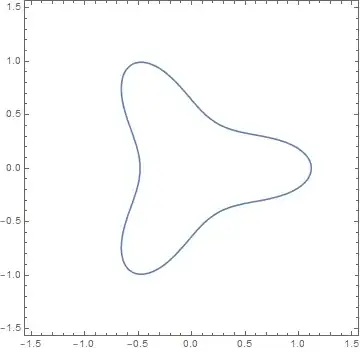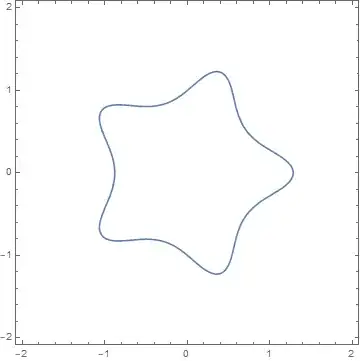You can get rotational symmetry of arbitrary order for the set of real zeros of bivariate polynomials.
One way of generating such polynomials is to use the arithmetic of complex numbers. For hopefully obvious reason the cubic
$$
R_3(x,y):=\operatorname{Re}\left((x+iy)^3\right)=x^3-3xy^2
$$
has the property that if $(x',y')$ is the point we get by rotating $(x,y)$ 120 degrees about the origin, then $R_3(x',y')=R_3(x,y)$.
Therefore it is obvious that the set of solutions of the polynomial equation
$$(x^3-3xy^2)+\frac16=(x^2+y^2)^2$$
exhibits this 3-fold rotational symmetry.

Similarly using $R_5(x,y)=\operatorname{Re}\left((x+iy)^5\right)=x^5-10x^3y^2+5xy^4$
we get 5-fold rotational symmetry in the zero locus of the polynomial
$$(x^5-10x^3y^2+5xy^4)+1-(x^2+y^2)^3.$$

I included a non-zero constant term and a high enough power of $(x^2+y^2)$ to guarantee that the set of solutions is a compact subset of $\Bbb{R}^2$, and that there is no singularity at the origin.
A few more remarks:
- The above curves actually have full dihedral symmetry, if you want to kill reflections as symmetries you can do tricks like those I used here.
- You can similarly find polynomials in $n$ variables such that their zero sets have any given finite group of $n\times n$ matrices as a symmetry.
- It is rare that the Galois group of a univariate polynomial has a nice geometrical interpretation. The dihedral groups do make an appearance as Galois groups of, say, $x^3-2$ or $x^4+2$, when the set of complex zeros exhibits a similar geometric dihedral symmetry (actually matching with the action of the Galois group on the set of roots).
- A reasonably often occurring symmetry among the roots of an irreducible polynomial is the case of the minimal polynomial $f_p(x)$ (over $\Bbb{Q}$) of $\alpha=2\cos(2\pi/p)$, $p>2$ a prime. Then we have the "symmetry" that if $r$ is a zero of $f(x)$, so is $r^2-2$. This comes from the fact that $2\cos2x=4\cos^2x-2=(2\cos x)^2-2$. If $m$ is not divisible by $p$ the formula for $\cos mx$ as a polynomial of $\cos x$ can similarly be translated into another symmetry among the roots.

